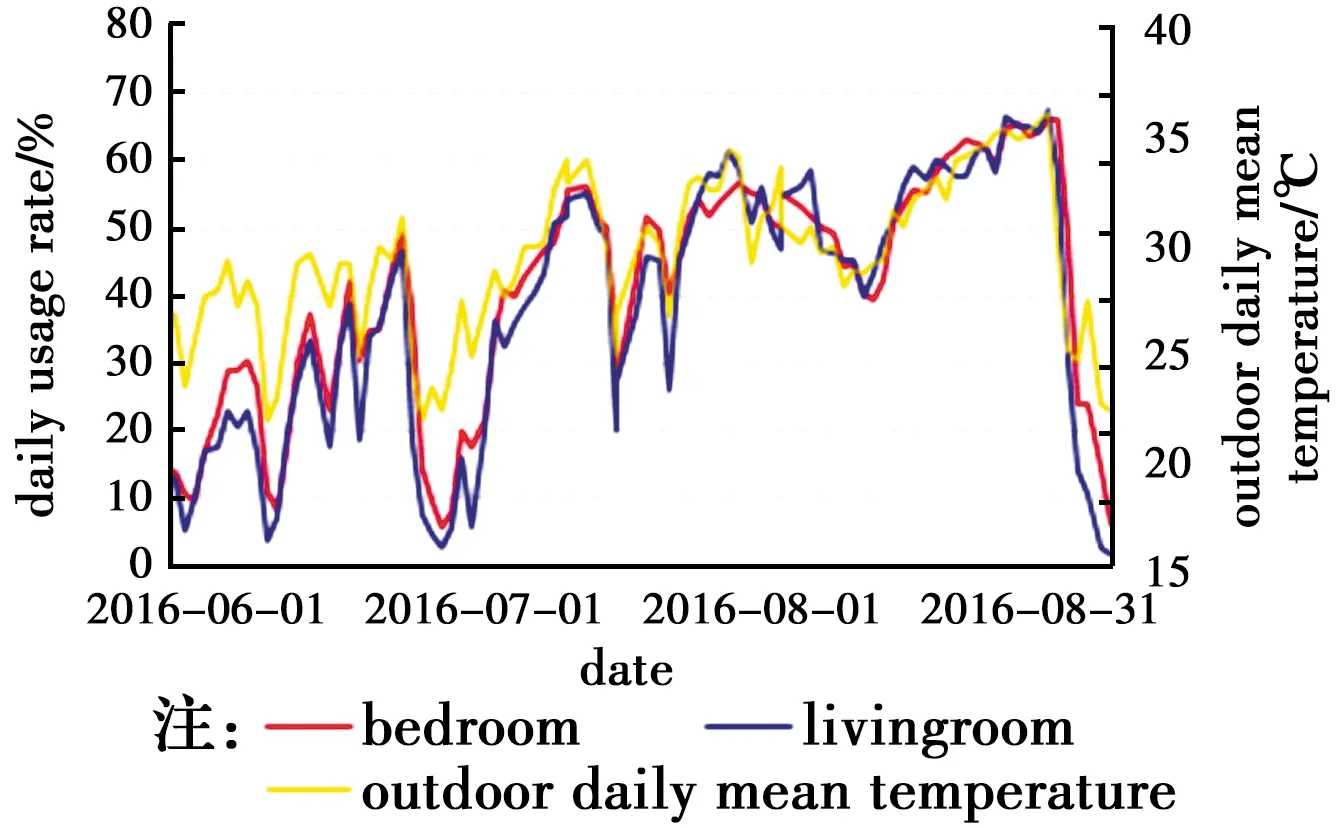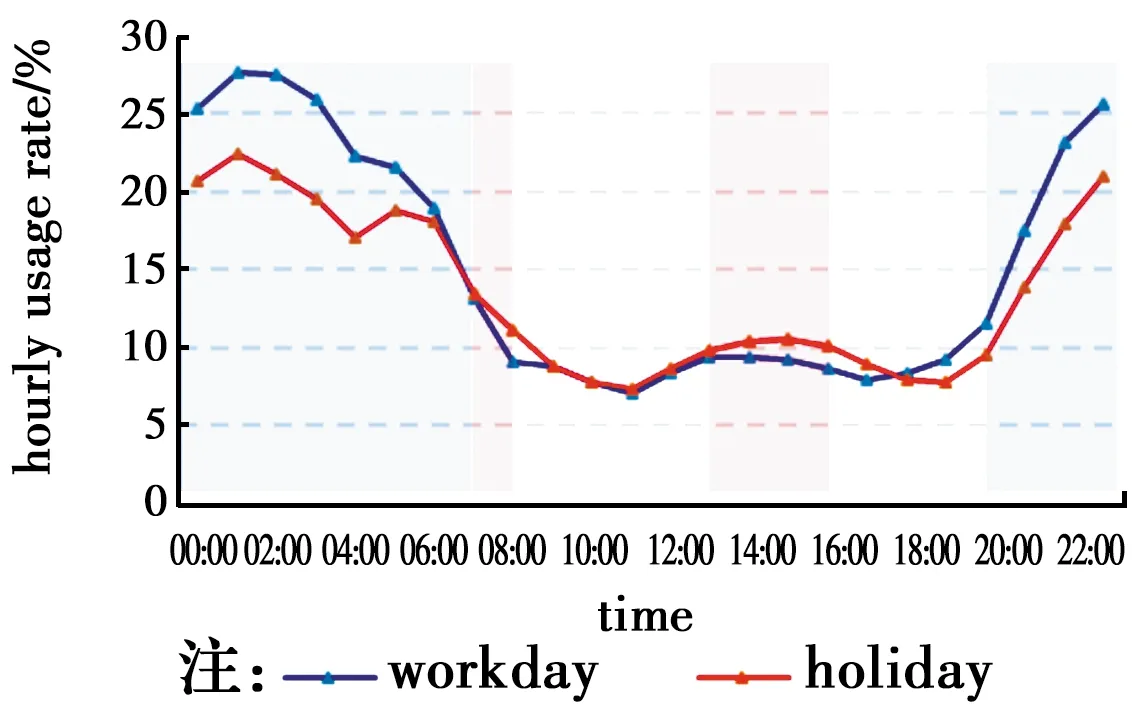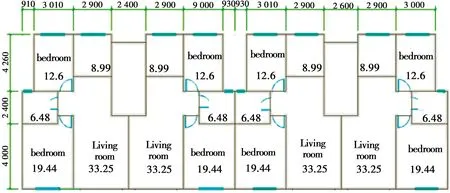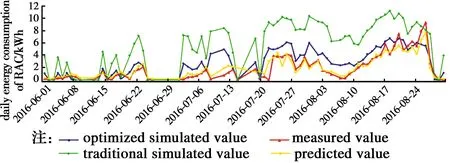Prediction model of energy consumption based on the actual monitoring data of room air conditioner usage rate and setting temperature
2020-06-15,,,,
, , , ,
(School of Civil Engineering; Joint International Research Laboratory of Green Building and Built Environment; National Centre for International Research of Low-carbon and Green Buildings, Chongqing University, Chongqing 400045, P.R. China)
Abstract: The energy consumption of air conditioning in residential buildings is determined mainly by the occupants. The key to predict the energy consumption of room air conditioning is to understand how occupants control their room air conditioners. Although the American Society of Heating, Refrigerating, and Air-Conditioning Engineers recommends a uniform occupancy schedule, occupants’ behavior patterns vary by region and time. Based on actual monitoring data obtained during 2016-06-01-2016-08-31, factors affecting the energy consumption of the room air conditioner such as the temperature setting and the daily/hourly usage rate were statistically analyzed, as well as the behavioral pattern of air conditioning usage in relation to the daily mean outdoor temperature. The result showed that occupants have a low tolerance to heat indoors and are likely to use the air conditioner even when the outdoor temperature is low. Then the results of the optimized energy consumption simulation model based on the traditional simulation model and the energy consumption prediction model were compared with the measured energy consumption. The results of the optimized energy consumption simulation model that adopted the daily usage rate and the energy consumption prediction model based on the temperature setting of the air conditioner, the outdoor daily mean temperature, and the length of daily operating time was closer to the measured value than the traditional energy consumption simulation model.
Keywords:air conditioner; usage rate; set temperature; energy consumption; prediction model
1 Introduction
Building energy consumption accounts for approximately 40% of global energy consumption[1]. To reduce building energy consumption, in China, building energy standards are implemented for residential buildings[2]. It is important to predict the residential energy consumption through known information in the absence of measured values in the design phase, but it is challenging to develop reliable models for the prediction. Recent studies have highlighted the disparity between predicted and measured energy consumption[3-4]. For example, it is reported that the measured value is about 70% higher than simulated results[5].
For an accurate prediction, it is necessary to establish what factors contribute to the residential energy consumption. Apart from physical characteristics such as climate, performance of the envelope, and size of the house, occupant behavior is also critical[6]. Many recent studies investigating the relationship between occupant behavior and air conditioning energy consumption have found the significant factors affecting room air conditioning energy consumption. Beköetal[7]concluded that the heating set point behavior of occupants plays an important part in determining the energy consumption in Danish dwellings. Jangetal[8]found that occupants’ general daily heating periods (25% deviation) were between three and eight hours, with temperatures set at between 17 ℃ and 20 ℃ in a total of 96 apartment blocks in Seoul. Other studies have analyzed air conditioner usage in relationship to climate change[9-10].We analyzed the temperature setting of the room air conditioner, the outdoor daily mean temperature, and room air conditioner usage utilizing a large amount of measured data, which is more accurate than participants’ self-recording[11]. In previous studies, data on room air conditioner usage was obtained mostly by investigation, and had a small sample size[12]. And simulations are not very accurate because of the standardization of room air conditioner usage. Fig. 1 shows current approaches to measuring the energy consumption of room air conditioners[13-14]. An air-conditioning usage model was set up connecting occupant behavior with the mean outdoor air temperature through the use of logistic regression[15]. However, the driving factors were mixed into a black box regression model that lacked explanatory power for the occupant behavior and model. A stochastic Markov model was applied in air-conditioning usage based on the probabilities of operation, where only one factor was included ignoring other factors[16]. A better model is needed. We developed an optimized simulation model and an interpretable physical meaning linear regression model to predict the daily mean energy consumption of the room air conditioner. The optimized simulation model uses logarithmic regression combining the traditional simulation and the room air conditioner usage rate in connection with the outdoor daily mean temperature. The energy consumption prediction model uses linear regression based on theoretical analysis, which has explanatory power for physical meaning according to the heat transfer expression of condenser and evaporator.

Fig.1 Summary classification of building energy consumption modeling and forecasting methods
2 Method
2.1 The samples
1990 room air conditioners were randomly selected from samples that were actually monitored from June 1, 2016 to August 31, 2016 in Chongqing. According to the difference in heating/cooling load between the bedroom and the living room, room air conditioners with a rated cooling capacity of less than 5 kW are generally placed in the bedroom, and more powerful ones are generally placed in the living room. Therefore, 72% of the samples were in the bedroom and 28% were in the living room. Only the largest class of samples with similar characteristics obtained by clustering were analyzed and predicted, resulting in a sample size of 170 room air conditioners in the living room and 490 room air conditioners in the bedroom. In order to ensure the reliability of the prediction model, 10 room air conditioners in the living room and 30 room air conditioners in the bedroom, which did not participate in the establishment of the prediction model, were randomly selected from the typical samples to verify the reliability.
The monitoring data of the operation of room air conditioners by occupants included the daily length of time the room air conditioner was run under different conditions, such as the temperature setting from 16 ℃ to 30 ℃, the wind speed modes, the usage modes and so on. We found that the significant factors affecting the air conditioner energy consumption were the amount of time the air conditioner was used, the temperature setting of the air conditioner, the occupant behavior pattern of switching it On/Off[17]. Therefore, the temperature setting and the daily usage rate of the room air conditioners were statistically analyzed.
We considered June 1 to August 31 as summer, as the average temperature in Chongqing in June, July and August is above 25 ℃. The statistical terms involved are defined as follows.
The outdoor daily mean temperature was obtained by calculating the arithmetic mean of the observations at four times: 02:00, 08:00, 14:00, and 20:00[18].
The average operating time at the set point ofts(℃) of room air conditioners in the bedroom/living room during summer can be defined as
(1)
wherehtsis the total operating time of the air conditioner at the set point ofts(℃) in the bedroom/living room during summer andntsis the total number of air conditioners operating at the set point ofts(℃) in the bedroom/living room during summer.
The daily usage rate in the bedroom/living room during summer can be defined as
(2)
wheremdis the number of room air conditioners operating on a day during summer in the bedroom/living room andNis the number of air conditioners in the bedroom/living room. The room air conditioner is considered to be in operation only when it runs for more than 10 minutes.
The hourly usage rate of room air conditioners on workdays/holidays in the bedroom/living room can be defined as
(3)
wheremh,ais the average number of room air conditioners operating at “a” o’clock during summer on workdays/holidays in the bedroom/living room andNis the number of air conditioners in the bedroom/living room.
2.1.1 Temperature setting of the room air conditioner
The temperature setting of room air conditioners is the main factor affecting energy consumption, which is affected by the outdoor environment, the occupants’ thermal sensation and energy saving awareness. Fig. 2 shows the average number of operating hours at each temperature setting in summer. Compared with the bedroom, occupants tend to set a lower temperature in the living room because there are more occupants and facilities in the living room with greater activity intensity. The running time of the room air conditioner in the bedroom is longer than in the living room. Overall, 26 ℃ is the most popular temperature setting, and the running time at low temperature settings (16~20 ℃) is shorter than at other other temperature settings.

Fig.2 Operating hours at each temperature setting
2.1.2 Outdoor daily mean temperature and daily usage rate of the room air conditioner
Fig.3 shows the daily usage rate of room air conditioners in the bedroom and the living room varies with the outdoor daily mean temperature. The daily usage rate of the room air conditioner in the bedroom is slightly higher than that in the living room. The daily usage rate of room air conditioners fluctuates between 5% and 70%, and the daily usage rate peak value occurs when the average interval is 10~20 days. Besides, the fluctuation law of the daily usage rate is close to the outdoor daily mean temperature. The daily usage rate of room air conditioners in June is relatively low at around 20%, while it is close to 50% in July and August, which is related to changes in weather. The average outdoor temperature in June is relatively low at around 26 ℃, while it increases to 31 ℃ in July and August, which is between 22 ℃ and 37 ℃ in summer.

Fig.3 Outdoor daily mean temperature and daily usage rate of room air conditioners
2.1.3 Hourly usage rate of the room air conditioner
Figs.4 and 5 show the hourly usage rate of room air conditioners on workdays and holidays in the bedroom and living room, which fluctuates between 3% and 30%. The hourly usage rate of room air conditioners in the bedroom on workdays ranges from 12% to 28% between 20:00 and 7:00, and on holidays it ranges from 10% to 22% between 20:00 and 8:00 and between 13:00 and 16:00. Different from the change in the bedroom, in the living room, the usage rate on workdays ranges from 10% to 26% between 11:00 and 24:00. And the hourly usage rate of room air conditioners in the living room on holidays ranges from 12% to 20% between 11:00 and 23:00. The results show that the room air conditioner in the living room is mainly used in the afternoon and before midnight, while that in the bedroom is mostly used at night. And it can also be seen that the usage rate at night (18:00-6:00) on workdays is significantly higher than that on holidays, which is related to the travel activities of the occupants.

Fig.4 Hourly usage rate of room air conditioners in the bedroom

Fig.5 Hourly usage rate of room air conditioners in the living room
2.2 Simulation parameters
The software DeST-h, which selects the common house type as the simulation object in the previous survey shown in Fig. 6, was applied for the energy consumption simulation. The simulated object was a 6-storey, 2.8-meter-high, north-south oriented plate residential building, and the area (m2) of each room was shown in fig.6. The window-to-wall ratio of the north-south direction was 0.4. According toDesignStandardsonResidentialBuildingEnergySaving65% (GreenBuildings) (DBJ 50-071-2016), the heat transfer coefficients of the external wall, exterior window, interior wall (floor) and roof were 1.0, 2.8, 2.0 and 0.8 W/(m2·K), respectively.

Fig.6 The simulated building plan
The simulated operating schedule of room air conditioners in the bedroom and living room on workdays and holidays shown in Figs. 7 was determined by the relative value of the hourly air-conditioning usage rate shown in Figs. 4 and 5, which is different between workdays and holidays because the occupants may be absent from the room for a trip on holidays. The gray box shown in Fig. 7 means the room air conditioner is operating.

Fig.7 Simulated operating schedule of room air conditioners in the bedroom and the living room on workdays and holidays
3 Results and discussion
3.1 Regression analysis of the daily usage rate
Fig. 8 shows the usage rate of room air conditioners relative to the outdoor daily mean temperature. Since the room air conditioners are mainly used at night and at noon, the outdoor daily mean temperature can better represent the overall outdoor temperature. Therefore, a regression model of the daily usage rate is constructed by the outdoor daily mean temperature. The logarithmic regression analysis of the daily usage rate (R) of the room air conditioner and the outdoor daily mean air temperaturetW(℃) indicated that:R(in the bedroom) =1.192 7 ln(tW) - 3.610 6,R2=0.79;R(in the living room) =1.412 2 ln(tW) -4.377 7,R2=0.86. By conducting F test, the sig≪0.01, indicating a significant correlation between these factors. The “L-curve” between the daily usage rate and the outdoor daily mean temperature shows that occupants have a low tolerance for a warm indoor environment and are likely to use air conditioners even when the outdoor temperature is low. When the outdoor temperature is low (20~25 ℃), 10%~30% of the room air conditioners in the living room and 5%~50% of the room air conditioners in the bedroom are still on.

Fig.8 Daily usage rate of room air conditioners and outdoor daily temperature scatter plot for bedroom and living room
3.2 Optimized energy consumption simulation model
The traditional simulation method based on the standardized room air conditioner usage schedule usually results in a large deviation between the simulation results and the measured results. Thus, we took the statistical parameter information shown in Figs. 3 and 7 as the input condition of the simulation software DeST-h. The temperature setting in the simulation model was 26 ℃, the one used longest by the occupants. According to the rated energy efficiency grade of air conditioners inTheMinimumAllowableValueoftheEnergyEfficiencyandEnergyEfficiencyGradesforRoomAirConditioners, (GB 12021.3-2010) the Energy Efficiency Rating (EER) of room air conditioners in the living room and the bedroom is assumed to be 3.2 and 3.4. Therefore, the traditional simulated daily energy consumption of room air conditioners can be calculated as follows.
(4)
whereLis the hourly simulated cooling load (kWh) andEdailypresents the traditional simulated daily energy consumption of room air conditioners (kWh). Then the optimized simulated daily energy consumption of room air conditioners combined with the daily usage rate is expressed as follows.
ES=Edaily×R
(5)
whereRis the daily usage rate of room air conditioners predicted by the outdoor daily mean temperature andESpresents the simulated daily energy consumption of room air conditioners optimized by the daily usage rate.
Figs.9 and 10 show the optimized and traditional simulated daily energy consumption of room air conditioners in the bedroom/living room, indicating that the optimized simulation model prediction shows better agreement with the measured results than the traditional simulation model. The deviation between the optimized simulated average daily energy consumption of the room air conditioner and the measured value is mainly within 0.5 kWh. For the bedroom, 82% of the relative deviation of the optimized simulated value is less than 50%, while approximately 70% of the relative deviation of the traditional simulated value is above 100%. Similarly, for the living room, 57% of the relative deviation of the optimized simulated daily energy consumption of room air conditioners is within 50%, while approximately 70% of the relative deviation of the traditional simulated value is above 100%.

Fig.9 Prediction of daily energy consumption in the bedroom

Fig.10 Prediction of daily energy consumption in the living room
3.3 Prediction model of energy consumption based on temperature setting
The room air conditioner is a vapor compression refrigeration system, therefore, the cooling capacityQ0, the input powerP, and the heat discharged from the condenserQkare mainly related to the evaporation temperatureT0(K) and the condensation temperatureTk(K) shown as follows[19].
P=QK-Q0=f(T0,TK)
(6)
QK=FRKCAC(TK-TW1)≈a(TK-TW)
(7)
Q0=F0K0A0(Tm1-T0)≈b(Ts-T0)
(8)
Here, the meaning ofFR,F0,KC,K0,AC,A0should refer toCoolingandHeatingSourceEngineering[19]andTw1(K) is the coolant (air) inlet temperature,Tm1(K) is the inlet air wet bulb temperature of the evaporator andTs(K) presents the daily mean temperature setting weighted by the operating duration.FRKCAC,F0K0A0are assumed to be the constant “a” and “b”.TW1is approximately replaced by the outdoor daily mean temperatureTwandTm1is approximately replaced by the temperature settingTs.
According to the calculation expression of the air conditioning system performance coefficient, Equation (9) can be obtained from Equations (7) and (8).
(9)
It can be seen that when the evaporating temperature and condensing temperature change little, the air conditioning performance is affected by the temperature setting and the outdoor daily mean temperature.
(10)
whereEa(kWh) is the actual monitored daily energy consumption of an air conditioner,Q(kW) represents the air conditioner rated cooling capacity, andh(h) means the daily operating time of an air conditioner.
Based on Equation (10), we constructed the daily energy consumption prediction model of room air conditioners in the bedroom and the living room by takingtw,Q,handtsas predictive variables. The linear regression analysis of the daily energy consumptionEaof the room air conditioner andTs(℃),Tw(℃),Q(kW),h(h) indicated that
h+1.086 3,R2=0.501
(11)
h+1.191 5,R2=0.533
(12)
By conducting F test, the sig ≪0.01, indicating a significant linear correlation between these factors.
Figs.9 and 10 show the average daily predicted energy consumption of the samples to be verified, which indicates that the accuracy of the prediction model based on equations (11) and (12) is close to the optimized simulation model mentioned in 3.2, and both are more accurate than the traditional simulation model. For the bedroom, the deviation between the predicted average daily energy consumption of the room air conditioner and the measured value is mainly within 0.5 kWh, and 60% of the relative deviation of the predicted value is within 50% and only 29% of the relative deviation is more than 100%. Similarly, for the living room, the deviation between 90% of the predicted average daily energy consumption of the room air conditioner and the measured value is within 0.5 kWh, and 63% of the relative deviation of the predicted value is within 50%, and only 21% of the relative deviation is more than 100%.
4 Conclusion
Recent studies have highlighted the disparity between predicted and measured energy consumption caused by failure to consider occupants’ behavior and the model’s lack of explanatory power. Therefore, the present study has proposed two prediction models based on the monitored daily energy consumption of room air conditioners in the bedroom and the living room. One of the prediction models is an optimized simulation model created by combining the traditional simulation model and the room air conditioner usage rate in connection with the outdoor daily mean temperature. The other energy consumption prediction model was developed by linear regression based on the theoretical analysis of the temperature setting, outdoor daily mean temperature, and length of daily operating time, which have explanatory power for the model’s physical meaning. The results show that the two prediction models, the accuracy of which are comparable, are more accurate than the traditional energy consumption simulation model.
The following conclusions could also be drawn from this study:
1) The deviation between the predicted average daily energy consumption of the room air conditioner and the measured value is mainly within 0.5 kWh, and 57%~82% of the relative deviation of the predicted value is within 50%.
2) The statistical analyses of the temperature setting and the daily usage rate of room air conditioners show that occupants tend to set the temperature at 26 ℃ and occupants have a low tolerance for indoor warmth since the daily usage rate and the outdoor daily mean temperature meet an “L-curve”.
The two prediction models are only applicable to room air conditioners with similar characteristics,but the method applied in establishing the models has reference significance for the energy prediction of room air conditioners. We analyzed only the summer working conditions of room air conditioners due to the dirth of samples in winter, which is related to the diversity of heating modes in Chongqing, but the method can also be applied to build the energy prediction model of the room air conditioner in winter.
